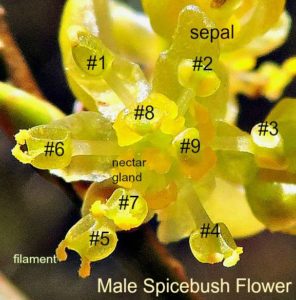
One of the most intimidating aspects of botany is the vocabulary. The technical vocabulary is necessary to describe plant details necessary for identification with precision, but little of it seems intuitive to beginners. I try to increase my botanical vocabulary slowly, as needed.
In the detailed monographs listed to the left I have italicized words that I have included in the glossary and I have aimed to keep it simple—for my sake! Botanical dictionaries and botanical picture dictionaries exists. A popular one that I find extraordinarily helpful is Plant Identification Terminology, An Illustrated Glossary by James G. Harris and Melinda Woolf Harris. Books or other on-line resources also often include their own glossaries, as in the Flora of Virginia.
Here’s another good on-line botanical dictionary: Plant Info Center at U. of N.C. at Chapel Hill
The following terms are used in italics in the species monographs.
Flower terms / Fruit terms / General plant terms / Leaf terms / Root terms / Seed terms / Stem terms
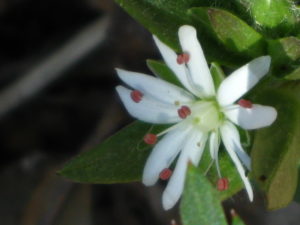
Flower Terms
bracts
usually looks like a small leaf where a flower stalk meets the plant stem. In unusual circumstances the bracts have color and become pronounced looking like petals as in dogwood flowers and poinsettia
catkin
an often drooping cluster of small, stalk-less flowers, doesn’t look like what one thinks of as a “flower”; more like a pipe cleaner
inferior
means “below” – an inferior ovary is the swelled organ where the seed develops that sits LOWER than the petals and sepals if viewed from the side or in cross-section
inflorescence
a flower head spike or cluster of flowers on a plant; the bloom(s)
insignificant
so small you can’t really see it without magnification; usually refers to flowers
ovary
flower organ that contains the ovules which mature into seeds
ovules
undeveloped part of the ovary which becomes the seed
panicle
an elongated cluster of flowers that matures starting at the bottom and working towards the tip
pedicel
stalk of a single flower within a cluster of flowers
peduncle
primary flower stalk of a solitary flower or cluster of flowers
petals
the second to bottom structure of the flower head usually in direct contact with the sepals. Petals are often large and colorful
pistil
reproductive part of the flower that contains the ovary and other parts and sometimes is shaped like a bowling pin in the center of the flower
pollen
the very tiny grains produced by male parts of a flower that fertilize the seeds and usually appear as fine yellow dust
raceme
an elongated cluster of flowers or berries tight along a stem that start bloom at the bottom and work their way upwards over time
sepal
the lowest structure at the bottom of a flower where the flower meets the flower stalk. The sepals often look like small leaves cupping the flower above, and in fact, function to protect the flower before it opens
spike
an elongated cluster of flowers with no individual stems or side branching
spiklet
the part of grasses and sedges that sticks upward like a spike and contains all the tiny flowers
stamens
male reproductive part of a flower that includes a filament (shaft) anthers (heads), and pollen
staminal tube
central tube of a flower sometimes left after all the individual flowers fall off
superior
means “above” – a superior ovary is the swelled organ where the seed develops that sits HIGHER than the petals and sepals if viewed from the side or in cross-section
terminal
the end tip of the highest stem or stalk
umbel
a flower head in which all the individual flower stalks radiate from a common point, like an umbrella
united sepal
sepals that are connected to each other towards the flower stalk
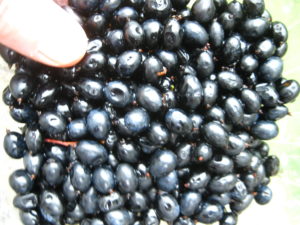
Fruit Terms
cone
a cone consists of seeds with overlapping outer thin papery or woody scales around a central axis
drupe
a berry with a single seed, usually a large seed
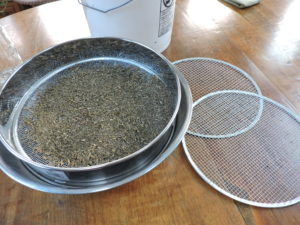
General Plant Terms
alteratives
the medicinal ability to restore the proper functioning to the body, gently over time, by eliminating wastes and improving metabolism
bud
a young, undeveloped leaf, flower or shoot enclosed in tight scales
cleaning screens
screens with different size openings to allow seed to fall through, but other plant parts to be captured and removed
desiccant
moisture absorbing material that pulls moisture out of an object to dry it thoroughly
dioecious
male flowers are on one plant, female flowers on another plant. Only female plants produces fruit and needs another male plant nearby in order to be fertilized
emetic
causing vomiting
extirpate
not extinct worldwide, but extinct within a given locale like a state, country or continent
family
a family subdivides into genera which related to each other, like siblings
flower
the reproductive part of a tree or plant that matures into fruit, seed or nut
genus (plural genera)
a genus subdivides into species, which are related to each other
herbaceous
plant whose stem is not woody
invasive
a non-native to the ecosystem, but now naturalized and thriving so well so that it is displacing natives through an unnatural competition
irregular
asymmetrically shaped flower
lenticels
visible small dots, slits, diamonds or triangular openings in the bark and twigs of trees and shrubs where gas exchange occurs withe the atmosphere, one way a plant breathes
mil
a thousandth of an inch measurement, plural is “mils”
monoecious
male and female flowers on the same plant, a plant that can self-fertilize
native
an indigenous species occurs naturally in an area, not introduced by humans
non-native naturalized
originally non-native to the area, but introduced into the area by humans accidentally or on purpose, and plant is now reproducing on its own with no further help. Often “naturalized” means it is a plant we “like” and it is not displacing native species or causing much harm to the local ecosystem
non-native invasive
originally non-native to the area, but introduced into the area by humans accidentally or on purpose, and plant is now reproducing on its own with no further help. Often “invasive” means it is a plant we “no longer like” because it is doing too well and taking over and is displacing or harming native species
regular
symmetrically shaped flower
shrub
a woody plant, smaller than a tree, often with multiple trunks, a bush
threshing
separating the seeds from the plant by beating, flailing, or somehow knocking the seeds off the plant
winnow
separating the loosened seed from the other undesired dried bits of flower and leaf using air currents to blow away the lighter bits and allowing the seed to fall and be captured
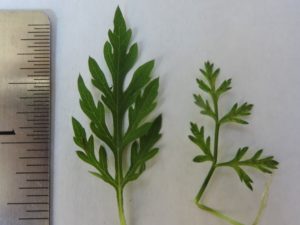
Leaf Terms
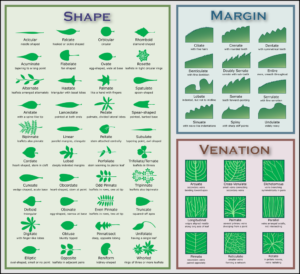
alternate
the arrangement of leaves or branches singly along a stem where the leaf stems are not directly across from each other or whorled but instead alternate up the stem with space between branches
apex
tip of leaf
axil
the spot on the stem or branch directly above the leaf stem (petiole
axis
the centerline extension of the leaf stem running the length of a leaf to the tip, which is where the midrib runs
basal
base of a plant at ground level
base
bottom of leaf that attaches to the leaf stem (petiole)
compound leaves
a leaf which is actually comprised of 3 or more leaflets along a central stem, as opposed to a simple leaf which consists of one leaf blade only. When the leaf drops off, the whole compound leaf falls as one
cordate
shape of leaf is heart-shaped
divided
same as compound leaf
entire
the edge of the leaf is smooth and not toothed
epidermis
leaf’s skin
lamina
leaf blade
leaflet
a single blade of a compound leaf. Leaflets share a common stem and all together they make up one compound leaf. Leaflets look like leaves, all lie in the same plane, but do not have new growth buds forming where they attach to the leaf axil
lobe
leaf blade has an undulating edge creating sections but none of the indentations in the leaf outline go completely to the leaf rib
margin
the side edges of the leaf
midrib
raised center vein running lengthwise down the center back of a leaf
monocot
a type of plant that usually has oblong or linear leaves with parallel leaf veins; also called a monocotyledon
opposite
the arrangement of leaves or branches in pairs directly opposite each other on a stem
ovate
shape of the leaf is like an almond or an eye
palmate
description of an arrangement of leaflets in a compound leaf–each leaflet attaches at a common point on the leaf stem like a palm leaf or the palm of your hand with fingers outstretched
petiole
stalk of leaf that connect to branch or twig. If no stalk it is called sessile
pinnate
description of an arrangement of leaflets in a compound leaf–each leaflet arranged basically alongside one another on opposite sides of the axis
polymorphic
plant with more than one shape of leaf
rib
raised main vein on back of a leaf
rosette
a dense cluster of leaves that form just at ground level in a ring around the center where the stem has or will emerge
serrated
edge of leaf that appears zigzagged, forward-pointing and sawblade-like; toothed
sessile
having no leaf stem, attaching directly to stem or twig
simple
a leaf with one leaf blade, with or without lobes but not consisting of many separate leaflets
sinus
space or indentation between two lobes or teeth of a leaf
stipule
an appendage or small leaf-looking part that emerges at the point the leaf meets the stem at the leaf axil
toothed
sharp pointed edges of the leaf, usually like a sawblade edge
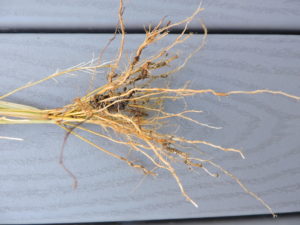
Root Terms
rhizome
an underground stem that is a creeping rootstock and sends out new roots; when divided, rhizomes can create new plants. Similar to stolons
stolon
runners, at the base of the plant. Thin, connecting runners that lay parallel along the ground connecting plant to plant, and sending out new roots. Like strawberry plants have
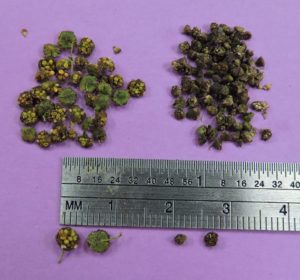
Seed/Nut Terms
achene
a hard, dry, single seed that does not open
awns
the stiff “whiskers” that stick up out of the seed heads of many grass grains and like wheat
chaff
the hulls, crumbly leaves, stems and papery parts of grains that are removed before the seed is eaten, loosely to mean the unwanted dried plants bits other than the seeds
hull
the outer part that covers a seed or grain
mast
the fruit of the plant. “Soft mast” is fleshy fruits like berries. “Hard mast” is nuts like acorns or walnuts
orthodox
seeds that can take airtight, dry, frozen storage and survive
pappus
think “dandelion fluff” or “parachute”–a feature mostly in the Aster family. Develops as the seed matures and the flower parts fall away–the seed is attached to the pappus “hairs” that help it lift and float in the wind
recalcitrant
seed is fussy and has high maintenance storage needs that cannot tolerate dry, airtight, frozen conditions
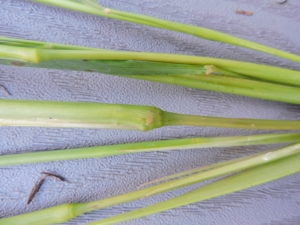
Stem Terms
internode
the section of a stem between where the leaves or branches attach
node
a swollen area on a stem, often look like a “knee” where a leaf attaches. Grasses have obvious nodes
rhizome
an underground stem that is a creeping rootstock and sends out new roots; when divided, rhizomes can create new plants. Similar to stolons
wing
a wing on a stem is a thin flat attachment to the stem that runs the length of the stem. The “wing” attaches perpendicular to the stem surface. A cut stem viewed it edgewise will display the wing in profile
